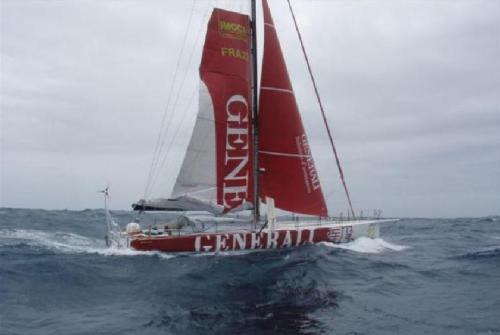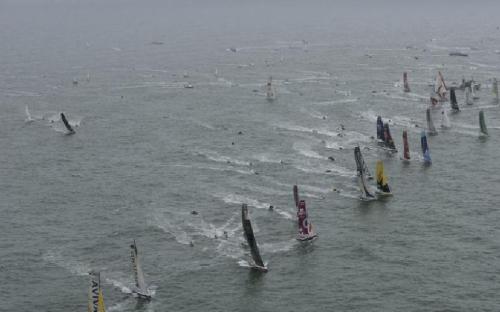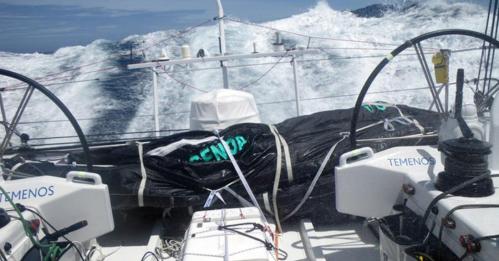I’ve always been fascinated by the Vendée. I was fascinated even before its first edition in 1988.
The Vendée Globe is a single-handed non-stop sailing race around the world, the only of its kind. It is the toughest sailing event there ever was – perhaps even the toughest sporting event, period.

Around all three capes. Non-stop, solo, unassisted.
There are other round-the-world sailing races, but the Vendée is the only one that is done alone, unassisted, without stopping. The Volvo, the Velux 5, the Barcelona World Race, the Global Challenge – these all have stopovers, and most are fully crewed. In 1998 Lock Ferguron actually did a faster 24-hour ocean sprint on his own that any of the crewed teams from the Volvo race. Of course, weather always plays a part, and perhaps he got lucky. Impressive nonetheless.
The Vendée Globe was actually born much earlier than 1988: 30 years earlier in fact, during the first ever non-stop round the world single handed race: the Golden Globe. Sailors everywhere (particularly single-handed sailors) had been inspired by Chichester’s famous voyage in Gypsy Moth IV, having sailed alone around the world, stopping only once in Australia.
Surely it could be done without stops? There were many who thought it possible, who thought that such an accomplishment could be theirs for the trying. A few were already preparing for the attempt when the Sunday Times came up with the idea of a race. Due to the yachtsmen being in various stages of readiness, they offered two prizes: a trophy for the first one around, and £5000 for the fastest.
 From the start it seemed clear that there were two main contenders: Robin Knox Johnston, the quiet Englishman on his home-built ketch Suhaila; and the Frenchman Bernard Moitessier, on his steel ketch Joshua.
From the start it seemed clear that there were two main contenders: Robin Knox Johnston, the quiet Englishman on his home-built ketch Suhaila; and the Frenchman Bernard Moitessier, on his steel ketch Joshua.
There were seven others, including ex-submarine commanders, Royal Navy officers, and Atlantic rowers. Many had no sailing experience whatsoever. And then there was Donald Crowhurst, the dark horse. In retrospect maybe the signs were already there, but at the time no one expected the tragic events that were to soon unfold in the South Atlantic.
The race started officially in June, 1968, though there was no starting gun. Entrants had to leave England any time between June and October, and the rules were simple: sail below each of the three capes eastward, to return to England. The first one back wins.

Alex Thompson's Hugo Boss
The Vendée Globe 2008
The Vendée has been going every four years since 1988, but this year offers a level of competition not seen before. Still all the same rules, but we now have an unprecedented thirty skippers from seven countries. About half the skippers have done the race before and have an idea of what’s coming. The other half must be scared shitless.
The Vendée (and most single-handed sailing events) are dominated by the French. The English have been challenging for years but just can’t seem to get it going.
The French just get out there and sail. They don’t moan about it, they don’t agonize over every decision. They just go. They sail like no-one’s business. There’s a deep complicated skill involved at this level of racing that the French have got a hold of somehow, but they’re not telling the rest of us how they do it. They are inscrutable. It’s in their blood.
The battle of the seas between England France has gone on for centuries. And so it goes still, with the French once more holding the upper hand.
Attrition
In the Golden Globe of 1968 four sailors retired before leaving the Atlantic, a fifth just after the Cape of Good Hope.
That left four:
Four: Donald Crowhurst went mad and threw himself overboard.
Three: Nigel Tetley sank only 1,000 miles from finishing. He later committed suicide.

Moitessier's Joshua
Two: Bernard Moitessier, the legendary French single-handed sailor, was happy at sea. He’d found his nirvana aboard Joshua, somehow forging an alliance with the fickle and cruel Southern ocean. He could have won the race if he had chosen to finish it. But he didn’t. Nor did he retire. He just decided, after rounding the three capes, that the race was sullying his experience at sea. So, after rounding Cape Horn, instead of heading north, Moitessier just kept sailing east, making another half circle of the globe before he eventually made port in Tahiti.
One: The Englishman Robin Knox Johnston was the only one to finish, thereby winning both the trophy for the first to finish, and the £5,000 for being the quickest. He still races to this day, and still wins.
The ultimate challange
I still want to do it. I know there is no salvation. I know the Southern ocean offers no hope. I know I don’t have the mettle. But I would still like to see it. The sea still runs through these veins.
It was Moitessier above all that sparked my passion for solo sailing. I still love it, though I’ve not done much of it lately. His book about the Golden Globe, The Long Way, is a melding of mysticism, poetry, and sound seamanship. He knew the way. He knew how to sail. He’s still revered in France. Last I heard, his boat, Joshua, was being used to teach kids the joys of sailing. I long to see her. Maybe one day I can.

Britain's Mike Golding
Vendée 2008: The Characters
I know a lot of these guys from previous Vendée Globes. There are a lot of veterans, particularly the French. We also have our own Mike Golding, Alex Thompson, Dee Cafferty, and four other Brits. There’s also an Austrian, a Swiss, a Spaniard, an American, and Canadian to boot.
There’s a distinct separation between the seasoned hacks and the new guys. The weathered sailors have a good idea what to expect, so they’ll be a little more relaxed, at least in theory. The rookies won’t know what hit them, but if history is anything to go by, they’ll get the bug, vowing to come back and do it again.
There are two women in this edition, both Brits: Dee Cafferi on Aviva and Sam Davies on Roxy. I enjoy following women in this race, for they tend to add a certain honesty and realism about their lives at sea that the men hold back. Catherine Chabaud; Anne Liardet; Isabelle Autessier – the legendary French female sailors that overcame so much and added a much-needed human element to the adventure. The men are usually so circumspect, especially the French. They will not tell you how they are feeling; to them this admits a weakness that another might capitalize on.

Dee Cafferi's Aviva
The Boats
Think of a nice comfortable family cruising yacht. Then think again. There’s very little in common between the two, except that they both float and get their power from the wind. The IMOCA Open 60’s are basically just huge surfboards. (They’re called Open 60’s to differentiate them from One Designs, the latter being built to a single specification by a single designer. The Open 60 is a 60-footer, and can be of virtually any design or construction, so long as it passes the rigorous safety tests, including self-righting ability).
My yacht, Someday, was a 37-foot cutter with loads of room below. Two could (and did) live comfortably aboard. All the mod-cons you might expect.

Vincent Riou's PRB
In contrast, the 60-foot boats used in the Vendée Globe are spartan below. Think of the inside of a race-car – all the creature comforts are removed for weight and safety. The navigation station is the main hub, with a serious amount of electronic displays. Radars, weather fax, GPS, plotters, wind data, boat instrumentation, computers galore.
There’s a small bunk nearby where you can catch a few winks – usually only 20 to 45 minutes at a time. Most boats don’t even have a working head. Just a bucket.
Their top speed is around 30 knots. In comparison, Someday’s top speed was 9.5 knots. Her only electronics were GPS and radar.

Very fast boats - and very wet
The Open 60’s are awesome machines. This time more than half the fleet are purpose built for this edition of the Vendée. This means faster, lighter, stronger: all around high-tech boats, worth millions of pounds each. And at least half of them are going to break. Keels falling off, rudders breaking, or, the most popular breakage: dismasting.
In order to even get around – and that is the paramount goal (except for the French – each and every one of them is in it to win) – each skipper has to balance a number of factors:
Racing
Most will be happy just to get around. Most of the rookies and those on older boats fall into this category.
The rest of the fleet are fiercely competitive. They will do anything within their power to get ahead and stay ahead. Especially the French, though don’t count out Mike Golding from England.

Broken keel
Breakage
You want to go fast, but the faster you go the more you risk breaking something. You are alone, at times thousands of miles from any port. To break something – even a halyard – can not only mean losing places but perhaps losing your life. This is not like driving a car, where road conditions are relatively predictable. The ocean is a fickle and ferocious animal, and conditions can change very quickly. Pounding through a 15 foot swell or surfing down 50-foot waves can really take their toll on a boat. The competitors will be flying the maximum amount of sail for the conditions, and then some.
The solo racing sailor is in a constant battle between keeping the speed up and saving the boat. Those whose goal is to finish will consider the boat in the first instance; those who are out to win will constantly be making difficult decisions: we’re going very fast, we need to keep going fast, but the boat’s taking a beating; will she hold up? Maybe I should change sails or drop a reef… When the (prudent) cruising sailor finds himself asking these questions, he changes sail. The racing sailor, on the other hand, will psyche himself out, play a battle of wits, all sail up while the barometer drops and the swell  grows – there’s miles ahead and boats right behind. But the cost of waiting just slightly too long to make that sail change can mean the end. The wind gusts just as the bows dive into a trough, the boat accelerating so hard that the bow slams into the wave rather than riding above it. And maybe this time the crash is little louder than usual, for the rig – all 30 metres of it – has just snapped. And now it’s survival mode. Sailboats aren’t very stable without their masts…
grows – there’s miles ahead and boats right behind. But the cost of waiting just slightly too long to make that sail change can mean the end. The wind gusts just as the bows dive into a trough, the boat accelerating so hard that the bow slams into the wave rather than riding above it. And maybe this time the crash is little louder than usual, for the rig – all 30 metres of it – has just snapped. And now it’s survival mode. Sailboats aren’t very stable without their masts…
Are these boats designed to be sailed full speed in treacherous conditions? Yes and no. The winners of the previous Vendée’s will say yes, if you look after the boat. The skippers dismasted will still say yes, but with a caveat: I was pushing too hard.
Only experience can instruct on the balance.
The sound below can be deafening, especially when beating to weather. The hulls are very thin, with no insulation, and everything is flexing and groaning. Windward, everything is crashing, no matter how well you stowed the lockers. It’s like the whole boat (and everything in it) is lifted up and then slammed back down – again and again.
You get used to which sounds are ‘normal’ and which are warnings. You can be fast asleep but your senses will tell you something has changed. Instantly awake, a moment later knowing either exactly what it is – and so charge into action – or, less welcoming, not knowing what it is. The heart beats faster, the adrenalin starts pumping. You’re in the middle of the ocean and it’s middle of night, pitch dark, and you hear the sound of water gurgling. There’s always water splashing past the hull and over the decks, but this sound, this sound shouldn’t be there. This is where we win or lose.
The solo racing sailor isn’t just a master sailor. Nor is he just a survivalist. He must also be an engineer, quick on his feet, ready to repair, rebuild, and outthink every single system on his boat. And there are a lot of them. Hydraulics, electronics, carbon fibre repair, generators, sail making, making something out of nothing. These sailors must also be master engineers.
Physical Survival
There are thousands of miles in the southern ocean where rescue is not an option. Almost all rescues during previous editions have been by other competitors rather than any Coast Guard. The route through the Southern ocean is too far from Australia and Chile for any hope of air rescue; help must come from the sea. Most times the only people remotely close by are your rivals.
Pete Goss’s rescue of Raphael Dinelli in 1996, and Mike Golding’s rescue of Alex Thompson during 2004’s Velux are two dramatic illustrations of how remote this area of the planet realty is.
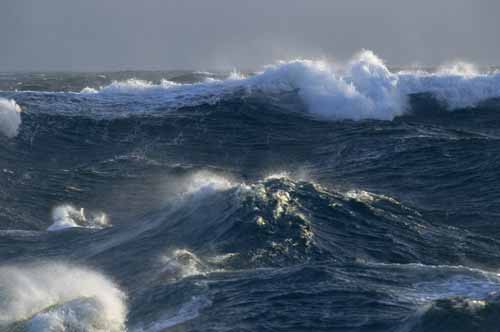 Mental Survival
Mental Survival
For me, this is probably the most intriguing challenge of solo sailing. In 2005, I sailed Someday solo across the Atlantic, a dream I’d had for years. That dream was fuelled by the likes of the original solo sailors – particularly Bernard Moitessier. Among other things, I was curious to see how I’d handle it mentally. I think I was striving for a Moitessier-like mystical existence on the open ocean, appreciating and using the voyage as a means to a deeper spiritual understanding of myself and my place in the world. I was fully rewarded on that front, but those moments were few, relative to the time I was out there. I also experienced a lot of frustration, fear, exhaustion, and seasickness. In the end it was just a matter of getting to the other side rather than relishing the adventure. There was no serenity in the adversity.
The sailors in the Vendée all have their own hopes for adventure, glory, and maybe even salvation. Some are back to overcome past failures – (Golding and Thomson come to mind); others to see through the final hurdle in their professional sailing careers. And then there are those who are doing it because they have to. It’s in their blood. (Bilou, Mich Desj, and Riou come to mind).

Sponsor's logos and colours
Sponsorship
Most of the sailors that participate in the Vendée are professionals. This is how they make their living. Who pays for it? Same way most successful athletes are paid: sponsorship, speaking engagements, book deals, media.
These are very, very expensive boats, with a lot of very expensive equipment that takes huge supporting teams and prepateurs to ensure they’re ready for the starting line.
Their commitments to sponsors continue through the months and years of preparation, right up to the start day. Sponsors have guests, they have commercial (and sometimes philanthropic) ambitions, and their investments must be shown a return. So sailor must smile, even though in these final days before the start he would much rather be home with his family or making miles out at sea.
In the Golden Globe back in 1969, sponsorship was both harder to come by and much less lucrative. It wasn’t the polished money-making media machine that it is today, or at least not for sailors. And their boats were most certainly not named for the money-men. But then again, many of the boats in the Golden Globe were home-built, or at best one-off designs targeted at the cruising sailor, and so much less expensive.
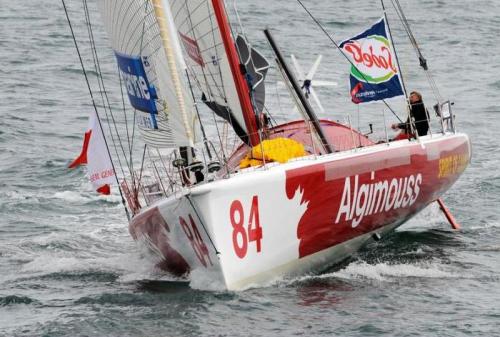
A French Sponsor for Canada
As you look at the Vendée boats leaving Sable d’Olonne, you may not recognize all the logos – that is because most of them are French. The French excel at this game. It’s in their nature. But rest assured, every boat out there is named for the company who sponsors her. Some say this is progress, that this will bring greater media attention and therefore more excitement from the general public. That must be good, but I have trouble justifying the means. Whatever happened to naming your boat after something meaningful to you, to you, the solo sailor who will spend three to four months alone aboard your boat, your constant and only companion?
What happened to Suilhila, Joshua, Gypsy Moth, Spray?
Attrition
Typically there’s a lot of action in the Bay of Biscay (between France and Africa). The Atlantic storms roll on through unimpeded until Biscay, where the land below shallows quickly. Combine this with a strong current and you’re up for a challenge. Many a Vendée boat has had to retire, turn back for repairs (allowed within a 7 day window from the start), or just throw in the towel.
It’s going to be brutal. Those that make it around the Cape of Good Hope under Africa will now be heading through the Indian and then the Southern oceans. This is where we’ll see even further carnage. The Southern Ocean is the loneliest, scariest, most dangerous place on the planet. Storms rage across thousands of miles of open ocean, unimpeded by land masses, growing in strength. Wave heights of 50 or 60 feet are the norm. This is serious sailing.
 Dismastings. Capsizes. Catastrophic failures. Icebergs. Daring ocean rescues. The Vendée Globe makes for an excitement-packed three months. Although the danger is real and serious, every boat is equipped with redundant communication systems, electronic beacons, life rafts, and other safety gear. But even the best technology is no match for the southern ocean. In 1992 the Canadian sailor Gerry Roufs was lost. His boat disappeared, and no signal from his automatic beacon was ever received. A year later part of the wrecked hull was found on the Chilean coast. To date he has been the only Vendée sailor to perish.
Dismastings. Capsizes. Catastrophic failures. Icebergs. Daring ocean rescues. The Vendée Globe makes for an excitement-packed three months. Although the danger is real and serious, every boat is equipped with redundant communication systems, electronic beacons, life rafts, and other safety gear. But even the best technology is no match for the southern ocean. In 1992 the Canadian sailor Gerry Roufs was lost. His boat disappeared, and no signal from his automatic beacon was ever received. A year later part of the wrecked hull was found on the Chilean coast. To date he has been the only Vendée sailor to perish.
Not so for the Golden Globe of 1968. Two lost their lives.
Well, some say one, but I say two.
The most well-known story of that race is that of Donald Crowhurst, the dark horse. He lacked off-shore sailing experience, and his boat, Teignmouth Electron, built specifically for this race, wasn’t ready for such a voyage. She hadn’t been tested properly; much of the necessary equipment had been left back at the dock; and Crowhurst himself had serious reservations about the voyage. But he felt he had to go. His business, his home, his reputation all depended upon a good showing.
Turns out that instead of sailing southwards down the Atlantic and then round Africa to the Indian Ocean, Crowhurst just sailed in lazy circles in the middle of the Atlantic, sending false position reports, faking his log, slowly going crazy with the effort of his duplicity.
He eventually jumped overboard, leaving his trimaran a-drift. His body was never found.
The second casualty of the 1968 Golden Globe was Nigel Tetley. He had sailed under the three capes and was within 1,000 miles of home when his ailing Trimaran finally sank. He was in the lead at the time. He was rescued, but the experience preyed on his mind. A year later he hung himself.
In past Vendée Globe races the attrition rate was about 50%, so this time, out of the 30 boats starting we can expect to see 15 making it home.
 What is it really like?
What is it really like?
I’ve not sailed an Open 60, nor have I sailed the Southern Ocean, so I can only extrapolate based on my own experience and my close interest in the event.
Solo sailing is richly rewarding, especially offshore at night, the wind 15 to 20, the sky dazzling with stars, the water swooshing past the hull, the boat happy, well-heeled, moving.
There’s a rich feeling of connection. All there is is boat, water, and sky. They all come together, and for a while you know them like nothing you’ve ever known before.
That’s the pleasant part.
But the wind picks up, and the seas build, and there’s nothing anywhere to stop the swell. The waves get higher and more fierce. At this point I heave-to – essentially putting the brakes on and calming the boat’s motion.
The Vendée sailors will not heave-to unless in a survival situation. There will be no rest. Their voyage will be both physically and mentally exhausting, every day, for 3 to 4 months. Even just sitting below on a heaving yacht takes energy; moving about to even more so. You are constantly battling the boat’s movements though the waves.
I went offshore for the pleasure and the challenge; these crazy fuckers are racing. I was never too tired to take in a reef – I am a very conservative sailor – but I was often too tired to shake one out. This dialog cannot happen for the Vendée skippers. Everything is about making the boat go as fast as possible within the boundaries you have set for yourself.
The Sailors
There are too many sailors to go into here, but I will mention a few that I will be following in the coming months.
 Michel Desjoyeaux / Foncia
Michel Desjoyeaux / Foncia
This is “Mich Desj”’s 2nd Vendée Globe. The “Proffessor” won the Vendée in 2000 (barely beating Dame Ellen Macarther), and is basically the most successful and highly regarded single-handed sailor in the world.
“In a single-handed race I consider that the boat makes one third of the result, two thirds is from the man”
 Vincent Riou / PRB
Vincent Riou / PRB
Very cool and collected – very wise about ‘not asking too many questions’.
Winner 2004.
 Roland (Bilou) Jourdain / Véolia Environment
Roland (Bilou) Jourdain / Véolia Environment
3rd time(3rd in 2000, retired in 2004), A Favourite. A mentor and friend to many of the other skippers.
 Mike Golding / Ecover
Mike Golding / Ecover
One of the 7 Brits, Golding finished 3rd 2004, after somehow completing the last 500 miles without a keel. I’ve been following him for awhile – I hope he does well.
 Jean-Pierre Dick / Paprec Virbac 2
Jean-Pierre Dick / Paprec Virbac 2
This is Jean-Pierre’s 2nd time around, finishing 6th in 2004. He is another favourite to win.
 Jean Le Cam / VM Materieaux
Jean Le Cam / VM Materieaux
Finished 2nd in 2004, only six hours behind Vincent Riou. You can bet he’s out to win this time.
 Sam Davies/Roxy
Sam Davies/Roxy
One of the two female contenestants, her ability to fix things explains her nick name: Ms. MacGyver. This is her first time around.
 Brian Thompson/ Bahrain Team Pindar
Brian Thompson/ Bahrain Team Pindar
The most extreme boat. It is heavier than the others, with a taller mast and heavier sails. The idea is a more stable boat, with fewer sail changes, while still remaining competitive. It will be very interesting to see how she performs.
Also interesting is the fact that Pindar is sponsored by the Kingdom of Bahrain.
 Derek Hatfield / Algimouss Spirit of Canada
Derek Hatfield / Algimouss Spirit of Canada
The only Canadian on the 1st Candian-built Open 60. I think he’s sailing more for the adventure rather than to win. He’s also working closely with Earth Rangers, an environmental charity.
 Rich Wilson / Great American III
Rich Wilson / Great American III
A successful mathemetician, oldest sailor in the fleet. Not a favourite to win, but I hope he finishes.
 Bernard Stamm / Cheminées Poujoulat
Bernard Stamm / Cheminées Poujoulat
A highly regarded sailor with many records to his name, Bernard has been around twice. 3rd time lucky?
 Dominque Wavre / Temenos II
Dominque Wavre / Temenos II
3rd time around. A swiss to watch.
 Raphael Dinelli / Foundation Ocean Vital
Raphael Dinelli / Foundation Ocean Vital
Had to be rescued in 1996. 4th attempt. Another one to watch.
 Alex Thompson / Hugo Boss
Alex Thompson / Hugo Boss
Alex is the one I’m rooting for. Some tremendous bad luck the last two times, and just two weeks ago was struck by a fishing boat off of Sables. The boat has been repaired, so hopefully he can still remain competitive. Most important will be Alex to get his head back into the right place.
 Dee Cafferi / Aviva
Dee Cafferi / Aviva
Sailed the “wrong way” around, the first woman to do so. If she completes this race she’ll be the first woman to sail non-stop around the world in both directions. Aviva is purpose-built for this Vendée, and is a sister ship to Mike Golding’s Ecover.
.
The race had already started!
See the Vendéeglobe website for full coverage, including an RSS feed.
Most (if not all) competitors also have their own websites with feeds or email lists.
Recommended reading:
A Voyage for Madmen, by Peter Nichols
A well-written account of the Golden Globe of 1968.
The Long Way, by Bernard Moitessier
The master’s account of the same race.






